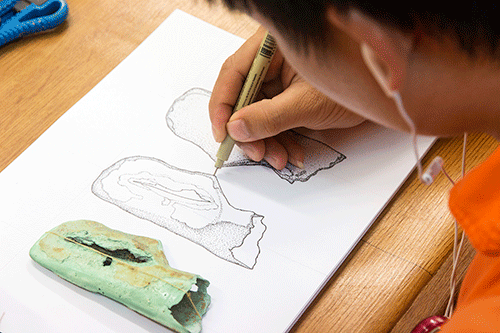-
Downloads
MMG LXML Sepon (LXML) is supporting 3,000 years of Lao history and heritage through partnership in archaeological research and cooperation with the Lao Ministry of Information, Culture and Tourism, National University of Laos, and Australia’s James Cook University.
Remarkable discoveries are being made at Sepon mine in Vilabouly District, Savannakhet Province. One of the most outstanding recent findings includes items used in early mining that have been carbon dated to approximately 3000 years ago. This places Vilabouly among the first locations for mining and metallurgy in Southeast Asian prehistory. Ancient mining continued around Sepon mine until around 1300 years ago (about 700 AD). These dates were derived from bamboo matting in ancient mine-shaft support structures, preserved in wet clay between 10m and 40m below the surface. Five sites with preserved wood and bamboo mining shaft structures have now been explored at Sepon mine.
Other recent finds include mining equipment such as wooden ladders and pulleys, mallets, painted bamboo baskets, and rope; all remarkably well preserved due to rare conditions in natural sediments. Many items, conserved by Dr Marion Ravenscroft and her team, are on display in Vilabouly Cultural Hall. Other important heritage finds include a large Dong Son era bronze drum on display at the National Museum in Vientiane. Crucibles, copper ingots, jewellery, ceremonial items, and other artefacts highlight Laos’ pivotal place in regional history. Heritage items are discovered as ‘chance finds’ during UXO (unexploded ordinance) clearance at Sepon. LXML has cleared over 45,000 pieces of UXO, making local communities safer.
This work has been made possible through a long-term partnership between MMG Limited, the Lao Department of National Heritage (Ministry of Information, Culture and Tourism), James Cook University, and the National University of Laos. Students from universities in Australia and Laos are cooperating with local communities to explore archaeological sites and preserve artefacts.
“This work shows how communities in Laos refined and exchanged minerals for thousands of years,” said Dr Nigel Chang from James Cook University. “Excavations at Sepon have uncovered a rich history of mining and settlement dating back thousands of years. Evidence of ancient copper mining shafts and ingots highlight the importance of mining in regional civilisations.”
“This program is extremely important in preserving ancient Lao culture as legacy for future generations,” said Dr Viengkeo Souksavatdy, Deputy Director General, Department of National Heritage, Ministry of Information, Culture and Tourism. “Vilabouly Cultural Hall showcases one of the most valuable archaeological collections in the Lao PDR.”

Mr Amphai Butphachit, an archaeologist with the Lao Department of National Heritage, Ministry of Information, Culture and Tourism, is drawing the fine details of a bronze axe recovered during excavations in Vilabouly. This artefact was used by Lao copper miners around 2000 years ago.
Media enquiries
Vannida Dejvongsa
Supervisor Communications, MMG LXML Sepon
T +856 21 268236
E Vannida.Dejvongsa@mmg.com
Downloads